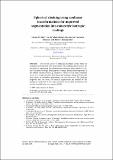| dc.contributor.author | Hu, Li | |
| dc.contributor.author | Zhang, Baile | |
| dc.contributor.author | Wu, Bae-Ian | |
| dc.contributor.author | Qiu, Cheng-Wei | |
| dc.contributor.author | Johnson, Steven G | |
| dc.contributor.author | Joannopoulos, John | |
| dc.date.accessioned | 2013-09-23T14:12:30Z | |
| dc.date.available | 2013-09-23T14:12:30Z | |
| dc.date.issued | 2009-07 | |
| dc.date.submitted | 2009-07 | |
| dc.identifier.issn | 1094-4087 | |
| dc.identifier.uri | http://hdl.handle.net/1721.1/80854 | |
| dc.description.abstract | Two novel classes of spherical invisibility cloaks based on nonlinear transformation have been studied. The cloaking characteristics are presented by segmenting the nonlinear transformation based spherical cloak into concentric isotropic homogeneous coatings. Detailed investigations of the optimal discretization (e.g., thickness control of each layer, nonlinear factor, etc.) are presented for both linear and nonlinear spherical cloaks and their effects on invisibility performance are also discussed. The cloaking properties and our choice of optimal segmentation are verified by the numerical simulation of not only near-field electric-field distribution but also the far-field radar cross section (RCS). | en_US |
| dc.description.sponsorship | Massachusetts Institute of Technology. Institute for Soldier Nanotechnologies (Contract W911NF-07-D-0004) | en_US |
| dc.language.iso | en_US | |
| dc.publisher | Optical Society of America | en_US |
| dc.relation.isversionof | http://dx.doi.org/10.1364/OE.17.013467 | en_US |
| dc.rights | Article is made available in accordance with the publisher's policy and may be subject to US copyright law. Please refer to the publisher's site for terms of use. | en_US |
| dc.source | MIT web domain | en_US |
| dc.title | Spherical cloaking using nonlinear transformations for improved segmentation into concentric isotropic coatings | en_US |
| dc.type | Article | en_US |
| dc.identifier.citation | Qiu, Chengwei, Li Hu, Baile Zhang, Bae-Ian Wu, Steven G. Johnson, and John D. Joannopoulos. “Spherical cloaking using nonlinear transformations for improved segmentation into concentric isotropic coatings.” Optics Express 17, no. 16 (July 21, 2009): 13467. © 2009 Optical Society of America | en_US |
| dc.contributor.department | Massachusetts Institute of Technology. Institute for Soldier Nanotechnologies | en_US |
| dc.contributor.department | Massachusetts Institute of Technology. Department of Mathematics | en_US |
| dc.contributor.department | Massachusetts Institute of Technology. Research Laboratory of Electronics | en_US |
| dc.contributor.mitauthor | Qiu, Cheng-Wei | en_US |
| dc.contributor.mitauthor | Zhang, Baile | en_US |
| dc.contributor.mitauthor | Wu, Bae-Ian | en_US |
| dc.contributor.mitauthor | Johnson, Steven G. | en_US |
| dc.contributor.mitauthor | Joannopoulos, John D. | en_US |
| dc.relation.journal | Optics Express | en_US |
| dc.eprint.version | Final published version | en_US |
| dc.type.uri | http://purl.org/eprint/type/JournalArticle | en_US |
| eprint.status | http://purl.org/eprint/status/PeerReviewed | en_US |
| dspace.orderedauthors | Qiu, Chengwei; Hu, Li; Zhang, Baile; Wu, Bae-Ian; Johnson, Steven G.; Joannopoulos, John D. | en_US |
| dc.identifier.orcid | https://orcid.org/0000-0001-7327-4967 | |
| dc.identifier.orcid | https://orcid.org/0000-0002-7244-3682 | |
| mit.license | PUBLISHER_POLICY | en_US |
| mit.metadata.status | Complete | |
